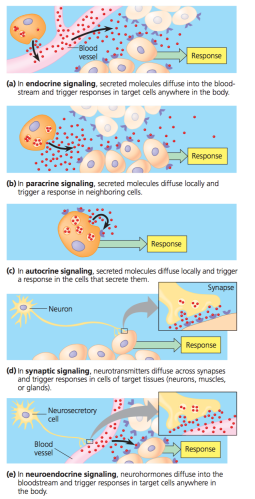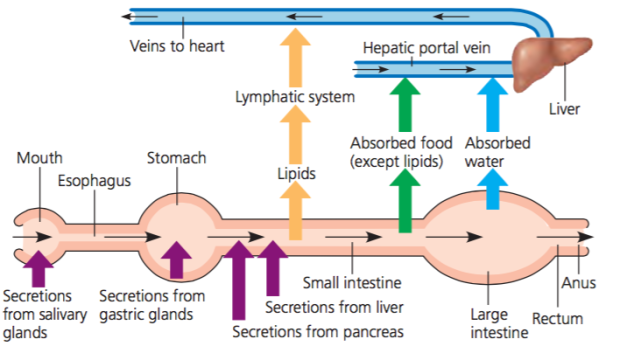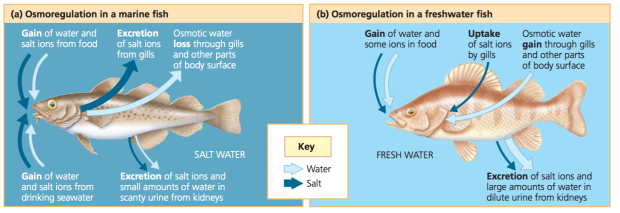Food and Its Path Through an Organism
Animals have diverse diets. Herbivores mainly eat plants; carnivores mainly eat other animals; and omnivores eat both.
An Animal’s Diet Must Supply Chemical Energy, Organic Molecules, and Essential Nutrients
Food provides animals with energy for ATP production, carbon skeletons for biosynthesis, and essential nutrients.
Essential nutrient: nutrients that must be supplied in preassembled form; includes certain amino acids and fatty acids that animals cannot synthesize;
Vitamins: organic molecules
Minerals: inorganic substances.
Animals can suffer from two types of malnutrition:
- an inadequate intake of essential nutrients
- a deficiency in sources of chemical energy
The Main Stages of Food Processing are Ingestion, Digestion, Absorption, and Elimination
 Food processing in animals involves:
Food processing in animals involves:
- ingestion: eating
- digestion: enzymatic breakdown of large molecules
- absorption: uptake of nutrients by cells
- elimination: passage of undigested materials out of the body in feces
Animals differ in the ways they obtain and ingest food.
Most animals are bulk feeders, eating large pieces of food
Intracellular digestion: food particles are engulfed by endocytosis and digested within food vacuoles that have fused with lysosomes
Extracellular digestion: used by most animals, enzymatic hydrolysis occurs outside cells in a gastrovascular cavity or alimentary canal
Organs Specialized for Sequential Stages of Food Processing Form the Mammalian Digestive System
Evolutionary adaptations of vertebrate digestive systems correlate with diet
Vertebrate digestive systems display many evolutionary adaptations associated with diet.
Dentition: the assortment of teeth, generally correlates with diet.
In addition, herbivores usually have longer alimentary canals than carnivores, reflecting the longer time needed to digest vegetation.
Many herbivores, including cows, also have fermentation chambers where microorganisms digest cellulose, a form of mutualism.
Feedback circuits regulate digestion, energy storage, and appetite
Nutrition is regulated at multiple levels
Food in the alimentary canal triggers nervous and hormonal responses that control the secretion of digestive juices and that promote the movement of ingested material through the canal.
 The availability of glucose for energy production is regulated by the hormones insulin and glucagon, which control the synthesis and breakdown of glycogen.
The availability of glucose for energy production is regulated by the hormones insulin and glucagon, which control the synthesis and breakdown of glycogen.
Vertebrates store excess calories in glycogen (in liver and muscle cells) and in fat (in adipose cells).
These energy stores can be tapped when an animal expends more calories than it consumes.
Several hormones, including leptin and insulin, regulate appetite by affecting the brain’s satiety center.
The Excretory System
Osmoregulation
Cells balance water gain and loss through osmoregulation
- Osmoregulation: a process based on the controlled movement of solutes between internal fluids and the external environment and on the movement of water, which follows by osmosis.
- Osmoconformers: isoosmotic with their marine environment and do not regulate their osmolarity
- Osmoregulators: control water uptake and loss in a hypoosmotic or hyperosmotic environment
- Transport epithelia: contain specialized epithelial cells that regulate the solute movements required for waste disposal and for tempering changes in body fluids
Protein and nucleic acid metabolism generates ammonia
- Most aquatic animals: excrete ammonia
- Mammals and most adult amphibians: convert ammonia to the less toxic urea, which is excreted with a minimal loss of water
- Insects and many reptiles, including birds: convert ammonia to uric acid, a mostly insoluble waste excreted in a paste-like urine
The kind of nitrogenous waste excreted depends on an animal’s evolutionary history and habitat.
Excretory System
Most excretory systems carry out filtration, reabsorption, secretion, and excretion.
- The protonephridia of the flat- worm flame bulb excrete a dilute filtrate.
- An earthworm has pairs of open-ended metanephridia in each segment that produce urine.
- In insects, Malpighian tubules function
- In vertebrates kidneys function in both excretion and osmoregulation
- Excretory tubules (consisting of nephrons and collecting ducts) and blood vessels pack the mammalian kidney
- Blood pressure forces fluid from blood in the glomerulus into the lumen of Bowman’s capsule
- Following reabsorption and secretion, filtrate flows into a collecting duct
- The ureter conveys urine from the renal pelvis to the urinary bladder
The Nephron
Within the nephron, selective secretion and reabsorption in the proximal tubule alter filtrate volume and composition.
- The descending limb of the loop of Henle is permeable to water but not salt; water moves by osmosis into the interstitial fluid
- The ascending limb is permeable to salt but not water; as the filtrate ascends, salt leaves by diffusion and by active transport
- The distal tubule and collecting duct regulate K and NaCl levels in body fluids. The collecting duct can respond to hormonal signals to reabsorb more water
In a mammalian kidney, a countercurrent multiplier system involving the loop of Henle maintains the gradient of salt concentration in the kidney interior.
In response to hormonal signals, urine can be concentrated in the collecting duct.
Urea, which leaves the collecting duct within the inner medulla, contributes to the osmotic gradient of the kidney.
The endocrine system
 Hormones and Specific Response Pathways
Hormones and Specific Response Pathways
The forms of communication between animal cells differ in the type of secreting cell and the route taken by the signal to its target.
- Endocrine signals: or hormones, are secreted into extra- cellular fluids by endocrine cells or ductless glands and reach target cells via circulatory fluids.
- Paracrine signals: act on neighboring cells, whereas autocrine signals act on the secreting cell itself.
- Neurotransmitters: also act locally, but neurohormones can act throughout the body.
- Pheromones: are released into the environment for communication between animals of the same species.
Distinct cellular responses are associated with water-soluble and lipid-soluble hormones.
- Polypeptide hormones and most amine hormones are water-soluble and bind to receptors embedded in the plasma membrane
- Binding of water- soluble hormones to cell-surface receptors triggers intracellular signal transduction, leading to specific responses in the cytoplasm or changes in gene expression
Steroid and thyroid hormones are lipid-soluble and readily enter target cells.
- There they bind to specific protein receptors in the cytosol or nucleus and its receptor act in the nucleus to regulate transcription of specific genes
Feedback Regulation
 Hormone pathways may be regulated by negative feedback, which dampens the stimulus, or positive feedback, which amplifies the stimulus and drives the response to completion.
Hormone pathways may be regulated by negative feedback, which dampens the stimulus, or positive feedback, which amplifies the stimulus and drives the response to completion.
Negative-feedback pathways sometimes occur in antagonistic pairs, such as the maintenance of glucose homeostasis by glucagon (from alpha cells of the pancreas) and insulin (from beta cells of the pancreas).
Insulin reduces blood glucose levels by promoting cellular uptake of glucose, glycogen formation in the liver, protein synthesis, and fat storage.
- Some neurosecretory cells in the hypothalamus produce hormones secreted by the posterior pituitary.
- Other hypothalamic cells produce hormones that are transported by portal vessels to the anterior pituitary, where they stimulate or inhibit the release of particular hormones.
The two hormones released from the posterior pituitary act directly on nonendocrine tissues
Oxytocin: induces uterine contractions and release of milk from mammary glands
Antidiuretic hormone (ADH): enhances water reabsorption in the kidneys
Often, anterior pituitary hormones act in a cascade. In the case of thyrotropin, or thyroid-stimulating hormone (TSH), TSH secretion is regulated by thyrotropin-releasing hormone (TRH).
TSH in turn induces the thyroid gland to secrete thyroid hormone, a combination of the iodine-containing hormones T3 and T4. Thyroid hormone stimulates metabolism and influences development and maturation.








